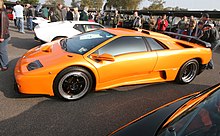Chrysler began looking for someone to take Lamborghini off its hands, and found it in a holding company called MegaTech. The company was registered in Bermuda and wholly owned by Indonesian conglomerate SEDTCO Pty., headed by businessmen Setiawan Djody and Tommy Suharto, the youngest son of then-Indonesian President Suharto. By February 1994, after $40 million had changed hands, Lamborghini had left Italian ownership, and MegaTech took over the automaker, its Modena racing engine factory, and the American dealer interest, Lamborghini USA. Djody, who also owned a 35% stake in troubled American supercar manufacturer Vector Motors, thought Vector and Lamborghini might be able to collaborate to improve their output. Michael J. Kimberly, formerly of Lotus, Jaguar and executive vice-president General Motors, was appointed president and managing director. After reviewing the entire Lamborghini operation, Kimberly concluded that the company needed to expand its offerings from more than just one or two models, and provide a car accessible to American car enthusiasts. He implemented a marketing strategy to raise awareness of Lamborghini's heritage and mystique. In 1995, Lamborghini produced a hit, when the Diablo was updated to the top-end SuperVeloce model. But in 1995, even as sales were climbing, the company was restructured, with Tommy Suharto's V'Power Corporation holding a 60% interest, MyCom Bhd., a Malaysian company controlled by Jeff Yap, holding the other 40%.

The Diablo would be Lamborghini's mainstay throughout the 90s, and was continually updated throughout the various changes in ownership.
Never leaving the red despite its increase in sales, in November 1996 Lamborghini hired Vittorio di Capua as President and CEO, hoping that the veteran of more than 40 years at auto giant Fiat S.p.A. could finally make the sports car maker profitable again. Di Capua immediately launched cost-cutting measures, letting go of a number of company executives and consultants, and overhauling production in order to achieve a 50 percent gain in productivity. In 1997, Lamborghini finally passed its break-even point, selling 209 Diablos, thirteen more than it needed to be profitable. Di Capua also leveraged the Lamborghini name and identity, implementing aggressive merchandising and licensing deals. Development of the "baby Lambo" finally began, moving forward with a $100 million budget.
 |
| Setiawan Djody also owned supercar maker Vector and hoped that Lamborghini and Vector would collaborate to the benefit of both companies. The Vector M12 pictured here has a Lamborghini V-12 engine |


0 nhận xét:
Post a Comment